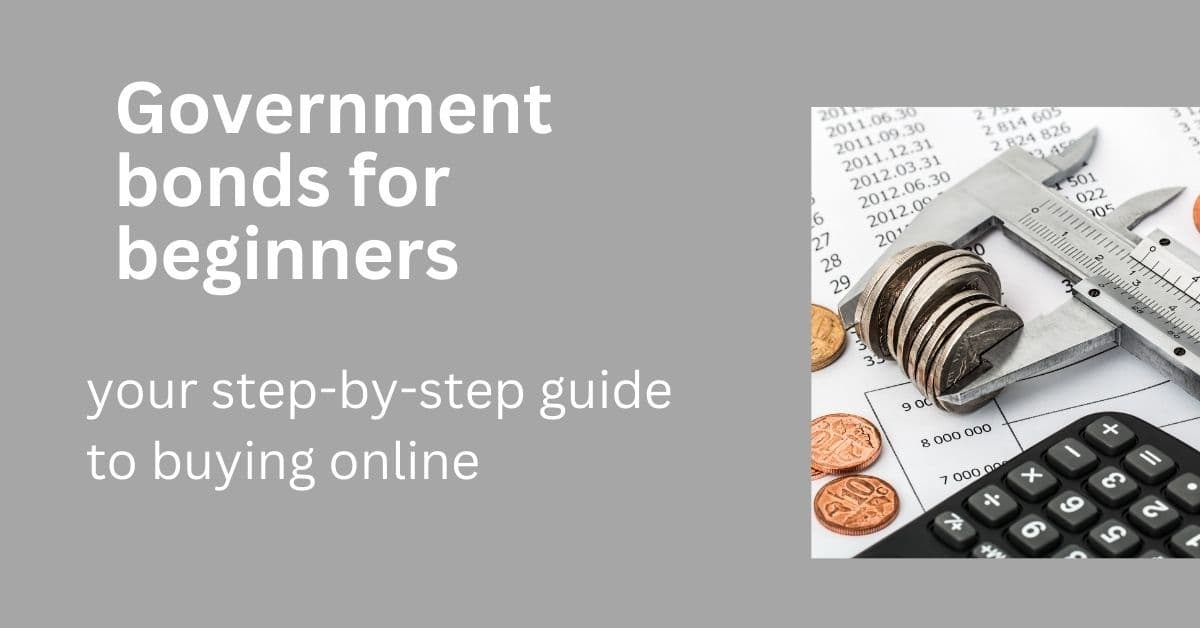Government Bonds for Beginners: In India, where millions of people place a high value on financial stability, government bonds stand out as a dependable and secure investment option. According to RBI data, as of 2025, there were over ₹100 lakh crore in government securities outstanding. These bonds are a reliable method to build your money without having to deal with the volatility of markets or the poor returns of savings accounts. Government bonds provide ease and consistency, regardless of whether you’re a senior in Chennai looking for a reliable source of income, a paid professional in Bangalore with ₹10,000 to invest, or a college student in Mumbai saving ₹5,000 from internships.
We’ll describe what they are, why they’re safe, how to purchase them online in a matter of minutes, and which bonds are best for your objectives, whether they be monthly income or a corpus of ₹1 lakh. Online investment has never been easier, especially with inflation at 5-6% and India’s digital economy increasing (UPI transactions reached 14.4 billion in February 2025). Let’s explore how to purchase government bonds with ease and begin building money right now!
Why Government Bonds are ideal for beginners in India
Government bonds are loans you make to the Indian government or state governments, which refund your capital at maturity together with interest (referred to as coupons). Consider them low-risk, predictable, and safe, similar to a government-guaranteed fixed deposit (FD). They’re perfect for novices because:

- Safety: government-backed; unlike corporate bonds, there is no default risk.
- Stable Returns: 6–8% annually; outperforms inflation (5–6%) and savings accounts (3–4%).
- Affordable Entry: No large funds are required; start with ₹1,000 to ₹10,000.
- Flexible options: include income or growth, short-term (1 year) or long-term (30 years).
- Tax Advantages: Certain bonds, like 54EC, are exempt from capital gains tax.
Buying bonds is now as simple as placing an online grocery order thanks to digital platforms like RBI Retail Direct and India’s expanding bond market, which is expected to reach ₹20 lakh billion in retail investments by 2025. Let’s see how novices can begin.
Government bonds for beginners: your step-by-step guide to buying online
Are you prepared to purchase government bonds? This comprehensive tutorial is designed for Indian beginners and includes 12 useful stages, examples, bond kinds, and advice.

Step 1: Recognise the nature of government bonds
What they are: Debt instruments issued by states or the Indian government, such as a ₹10,000 bond with a 7% interest rate that yields ₹700 annually.
Types:
- Fixed rate bonds: Bonds with a fixed rate pay 7% interest consistently until they mature.
- Bonds with floating interest rates: Interest rates fluctuate between 6.5% and 7.5%.
- Savings bonds: Retail-focused savings bonds, such as the RBI 7.75% Savings Bond, are available.
- Sovereign Gold Bonds (SGB): Gold-linked Sovereign Gold Bonds (SGB) have a 2.5% interest rate plus price increases.
- State Development Loans (SDL): State-issued, 7–8% are State Development Loans (SDL).
Why It Matters: It aligns objectives—savings bonds for retirees, SGB for gold enthusiasts.
For instance, Anil purchases ₹10,000 SGB, or ₹250 year plus gold growth.
Take action: Before April 20, 2025, read the RBI’s bond FAQ.
Step 2: Understand Why Bonds Outperform Other Investments
In contrast:
- Account for Savings: 3-4% — 10,000 ₹ = 400 ₹ annually.
- FD: 5-7%—₹10,000 = ₹700 annually, subject to taxes.
- Bonds: safer, 6-8%—₹10,000 equals ₹800/year.
- Risky stocks: 10–15%; a ₹10,000 investment might decrease to a ₹5,000 one.
Why for Beginners: No market fluctuations—a 7% yield on a ₹1 lakh bond is guaranteed to be ₹7,000 annually.
For instance, Priya’s ₹50,000 bond yielded ₹3,500 year at a 7% interest rate, while she saved ₹1,500.
Action: By April 25, 2025, list the advantages of bonds over FD.
Step 3: Look at the Best Government Bonds for Beginners
Top Bonds:
1 The 2020 RBI Floating Rate Savings Bond:
- Interest: 7.15% (linked to NSC + 0.35%, resets every six months).
- Lock-in tenure of seven years (4-6 years by age).
- ₹1,000 is the minimum.
- Why: Senior citizen exits, flexible rate.
2. SGB, or Sovereign Gold Bond:
- Interest: 2.5% plus increases in the price of gold (₹5,000/g in 2025).
- Eight years; leave after five.
- 1g (₹5,000) is the minimum.
- Why: Protect against inflation and tax-free profits.
3. Interest rate on the discontinued 7.75% savings bond (similar bonds are still available):
- 7.75% (new bonds).
- Duration: 5–7 years.
- ₹1,000 is the minimum.
- Why: Low entry and steady revenue.
4. 54EC Capital Gains Bonds (REC, NHAI): 5-6% interest rate
- Duration: 5 years.
- Minimum: 10,000 naira.
- Why: Reduce capital gains tax by ₹20 lakh.
For instance, after five years, Sunita’s ₹10,000 SGB increased to ₹15,000 plus ₹1,250 in interest.
Take action: by April 30, 2025, by selecting an RBI or SGB bond.
Step 4: Determine Your Eligibility
Who Can Purchase:
- Individuals, trusts, and HUFs (18+).
- Residents—most bonds do not apply to NRIs.
- minors through their parents (e.g., ₹5,000 for children).
Why It Is Important: All are welcome: ₹1 lakh suited salaried people, ₹1,000 suits students.
For instance, 20-year-old Anil purchased ₹5,000 SGB through his father.
Action: By May 05, 2025, confirm your identity (Aadhaar, PAN).
Step 5: Open an RBI Retail Direct Account
What to Do: Register at RBI Retail Direct (free, launched 2021).
Steps:
Visit website, click “Register.”
- Enter PAN, Aadhaar, mobile, email.
- Link bank account (e.g., SBI, HDFC).
- Verify OTP—account active in 24 hours.
Why It Works: Buy bonds directly—₹10,000 in 5 minutes, no broker fees.
Example: Priya opened her account—bought ₹20,000 bond same day.
Action: Register by May 10, 2025.
Step 6: Make Use of Different Platforms
Choices:
- Banks: ICICI, SGB, SBI, savings bonds (100 naira).
- Exchanges for stocks: NSE, BSE—secondary market G-Secs (broking of ₹50).
- SGB subscriptions are free at post offices.
- Apps: Groww—G-Secs, Zerodha, and SGB (for ₹200).
Why It Is Important: Several channels—tech-savvy people can get ₹5,000 SGB using Zerodha.
For instance, Sunita easily purchased a ₹10,000 bond from SBI.
Take action by linking your bank or Zerodha by May 15, 2025.
Step 7: Begin modestly with between ₹1,000 and ₹10,000
- How to Proceed: Invest ₹5,000 in SGB or ₹1,000 in RBI Floating Rate.
- The Reason It Works: Safe habit: ₹1,000 at 7% equals ₹1,700 after 7 years.
- After-depth: a down payment for a home of ₹5,000 per month at 7% is equal to ₹6 lakh after 20 years.
- For instance, after three years, Anil’s ₹5,000 SGB generated ₹625 + ₹2,000 in gold gains.
- Take action by May 20, 2025, by purchasing a ₹1,000 bond.
Step 8: Select Growth or Income Options
- Revenue: ₹7,150 annually on ₹1 lakh (semi-annual) at the RBI Floating Rate.
- Growth: SGB— ₹1 lakh (8 years) plus ₹40,000 in gold gain plus ₹12,500 in interest.
- Why It Is Important: Young people choose progress (₹10 lakh in 20 years), whereas retirees want income (₹5,000 per month).
- For instance, Priya’s ₹50,000 RBI bond covers bills and yields ₹3,575 year.
- Take action: by May 25, 2025, to determine income versus growth.
Step 9: Recognise the Tax Laws
- Bonds issued by the RBI: Interest is subject to tax (₹1,400 at 20%).
- SGB: capital gains tax-free at maturity, 2.5% interest-taxable.
- 54EC: Saves ₹20 lakh in capital gains, but interest is taxed.
- Why It Is Important Net return: ₹5,600 after taxes (20% slab) less ₹7,000 interest.
- Hacks: 54EC for selling real estate (saving ₹50 lakh) and SGB for tax-free earnings.
- For Example: Sunita’s ₹1 lakh SGB—₹20,000 gain tax-free is one example.
- Take action: by May 30, 2025, to check your tax slab.
Step 10: Track and Automate Investing
- How to Proceed: For bonds, set up UPI auto-pay (₹5,000/month) and monitor using RBI Retail Direct.
- The Reason It Works: Discipline: ₹12 lakh in 15 years at a rate of 7% per month, or ₹5,000.
- Hacks: Apps such as ET Money can track a ₹1 lakh portfolio in just five minutes.
- For instance, in seven years, Anil’s ₹10,000 monthly auto-pay accrued ₹5 lakh.
- Take action: By June 05, 2025, set up a ₹1,000 auto-pay.
Step 11: Use bonds to diversify
- How to Proceed: Combine RBI bonds (₹50,000), SGB (₹50,000), and 54EC (₹1 lakh).
- Why It Is Important: balances tax savings (₹20 lakh), growth (₹20,000 gold), and income (₹3,500 year).
- Hacks: ₹1,500 + gold gains (₹10,000 SGB + ₹10,000 RBI bond).
- For instance, Priya’s ₹2 lakh mix consists of ₹10,000 revenue plus ₹50,000 growth.
- Take action: By June 10, 2025, plan a ₹20,000 mix.
Step 12: Reinvest Returns
- How to Proceed: Invest ₹7,000 year in SIPs (12%) or higher bonds.
- The Reason It Works: Compounding wealth, ₹5,000 annually at 12% equals ₹2 lakh after 15 years.
- For Example: Sunita’s ₹3,500 interest in SIPs, for instance, would be worth ₹1 lakh in ten years.
- Take action: By June 15, 2025, begin a ₹500 SIP with interest.
Top Government Bonds for Beginners in 2025

In search of secure investments that will yield high profits in 2025? These are the best bonds to think about. Great for consistent income, the RBI Floating Rate Bond has a 7-year tenure, a variable interest rate of 7.15%, and a minimum commitment of just ₹1,000. In addition to paying out 2.5% interest, Sovereign Gold Bonds (SGBs) offer tax-free payouts after eight years, making them an excellent inflation hedge. 54EC Bonds, with a minimum of ₹10,000, provide 5–6% yields over 5 years for investors wishing to reduce their capital gains tax. Last but not least, State Development Loans (SDLs) are the best option for low-risk, long-term returns since they offer 7–8% interest, are backed by the government, and have terms of 5–10 years.
Advantages of Government Bonds for Beginners
- Safety: ₹1 lakh is safe for ten years with zero default.
- Returns: ₹5,000–₹10,000 year on ₹1 lakh—better than a 3% reduction.
- Simple: Purchase online with RBI Retail Direct in five minutes.
- Goals: ₹5 lakh for housing and fees in ten years.
- Tax Benefits: 54EC saves ₹20 lakh, and SGB profits tax-free.
Examples from Real Life
Anil’s Student Beginning
Anil, a 22-year-old Hyderabadi intern earning ₹5,000 per month:
- Bond: 10,000 SGB.
- Earned: ₹250 year plus ₹5,000 in gold over three years.
- “Simple and safe,” he says.
Priya’s Pay Schedule
Mumbai resident Priya, 30, makes ₹50,000 a month:
- Bond: RBI Floating Rate of ₹50,000.
- Earned—bills paid—₹3,575 annually.
- “No investment in stress,” she says.
The Retirement Income of Sunita
Sunita, a 60-year-old retiree from Chennai:
- Bond: ₹50,000 SGB + ₹1 lakh 54EC.
- Gained: ₹20,000 in gold plus ₹6,000 annually.
- “Protected my future,” she says.
Additional Advice for Beginners
- Festive Cash: ₹15,000 over eight years—₹5,000 as a Diwali present to SGB.
- Tax Plan: 54EC for the sale of real estate—tax savings of ₹20 lakh.
- Digital Ease: No broker, free RBI Retail Direct.
- Small Objectives: ₹1,700 in seven years (₹1,000 bond for phone).
- Learn: Pattu’s Finance on YouTube on the fundamentals of bonds.
- Diversify: Balance risk by diversifying with ₹10,000 SGB and ₹10,000 FD.
- Monitor: Keep an eye on your ₹50,000 portfolio each month using the RBI app.
Typical Problems and Their Solutions
- Problem: Fear of complexity is the challenge.
Solution: Purchase a ₹1,000 RBI bond in five minutes. - Problem: Poor returns in comparison to stocks.
Solution: The answer is to choose SGB—2.5% plus 5–10% gold gains. - Problem: The problem is lock-in times.
Solution: Select SGB and leave after five years. - Problem: Confusion around taxes is the challenge.
Solution: Use ClearTax to get the solution: ₹1,400 tax (20%) equals ₹7,000 interest. - Problem: No large sum of money.
Solution: ₹1,000 bond—₹7,000 in 20 years is the solution.
Why Bonds Are Beneficial for Beginners
The ₹100 lakh crore Indian bond market is a refuge of safety:
- Trust: 50 million investors, supported by the government.
- Digital Shift: 70 million UPI users at RBI Retail Direct.
- Economic Fit: 7% bonds protect wealth, 5-6% inflation.
Resources and Tools
- Apps: ClearTax (tax), Zerodha (G-Secs), and RBI Retail Direct (bonds).
- Websites: Moneycontrol (advice) and RBI (bond information).
- Freebies: include YouTube courses and bond calculators from BankBazaar.
- Communities: For advice for beginners, see r/IndiaInvestments.
Purchase Bonds Now
Begin your bonding adventure right now:
- By April 20, 2025, register with RBI Retail Direct.
- Purchase a bond of ₹1,000 by April 30, 2025.
- By May 05, 2026, aim for a portfolio of ₹10,000.
Your secure route to money is through government bonds. To encourage wise investment, share this information with your loved ones. Any novice Indian may purchase bonds with ease by following these instructions!
Best SIP Plans for Students to Start Small & Grow Big
How to Invest in Index Funds without Risk: A Beginner’s Guide
SIP in Mutual Funds: A Step-by-Step Guide for Beginners

